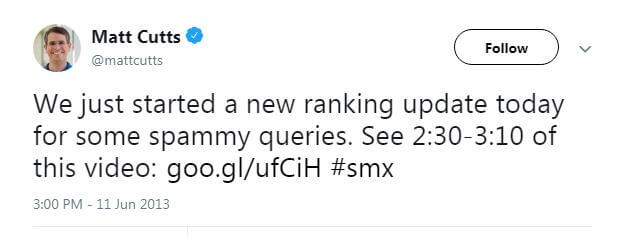Payday Loan: Targeting Spammy Queries And Websites
-

Aaron Gray
-
 April 27 , 2023
April 27 , 2023 -
 4 min read
4 min read
Payday Loan: Targeting Spammy Queries And Websites
Google rolled out the Payday Loan update on June 11, 2013. It focused on identifying spammy websites and devaluing them in the SERPs. The algorithm change was significant enough to be noticed by regular users and site operators.

Matt Cutts, Google’s head of anti-webspam at the time, posted on Twitter that they rolled out a ranking update that targeted spammy queries and websites. A month before, he has already hinted at the impending changes in a video announcement where he talked about how the search engine will display more relevant results for general queries such as payday loans and pornography-related ones.
Apparently, lots of users complained about this type of searches especially in the UK where there were instances of a breach or compromise of customer data due to shady sites being displayed in the results pages. The first payday loan filter, which was mainly a general clean-up of the SERPs, was launched over two months. The next updates wouldn’t be until the following year.
What Were Its Effects
The official impact was reportedly for 0.3 percent of English queries and a whopping four percent for Turkish searches since there were more spam incidents associated with the language. Websites that were deemed as spammy by the algorithm were penalized and devalued from Google searches. A majority experienced a drop in rankings while some were delisted entirely.
What It Means For You
With the subsequent updates for the payday loan filter, Google has fine-tuned its system to display relevant and trustworthy websites for this type of queries. Plus, the implementation of the Financial Conduct Authority or FCA regulation in the UK introduced a price cap on daily interest rates and stricter terms for the selling of data which meant that operating costs soared and entry to the industry appeared to be more difficult.
Google also rolled out a ban on pay-per-click or PPC ads for payday loans and related products back in 2016 to protect users. This move was a controversial one considering it appeared to only target companies with high annual percentage rates or APRs and short repayment terms.
These are the trends in UK searches that came out after the first payday loan update launched:
- Direct Lenders Took Over the First Page Direct providers of payday loans gained the top spots after the algorithm change rolled out. They won against comparison websites for this particular query despite the latter dominating search results for life and car insurance as well as personal loans.
- Exact-Match Domains were Nowhere in Sight It seemed as if Google was prioritizing brands over exact-match and partial-match domains since none of them were displayed in the top 10 results for the query. Again, this instance is unlike other types of searches such as logbook loans where a website with the primary keyword in their URL ranked first in the SERPs. If you operate a site with these search terms, you should have a high visitor engagement, an average time on site as well as low bounce rates to get quality organic traffic.
-
Domain Age Doesn’t Matter, but Links Do Domain age has always been a ranking signal used by Google to assess the relevance of a website. However, after the payday loan update rolled out, this particular factor didn’t seem to matter with sites that are less than two years old getting the top positions in the SERPs. This may be due to the fact that younger domains may have accumulated less spam and has a lower number of low-quality links.
Conversely, links still had a significant impact on how high your website ranks in the results pages. Find sites with high domain authority and without a spammy history since your connections can influence whether your domain ranks high in the SERPs or gets served a penalty. -
UX is More Crucial Than Ever Moreover, user experience continues to be an essential part of SEO. Websites that had a straightforward layout and allowed users to apply for payday loans easily ranked well in the results pages over those that focused on explaining what this type of loan is.
Basically, it merely takes an understanding of users and their intent when typing in a payday loan query; which usually is about finding the best deals with the lowest interest rates online.
Successful websites maximized the use of calculators, images, and videos to increase the number of applications. Ultimately, avoid publishing thin content that doesn’t provide users with valuable information about the general theme of your site.

